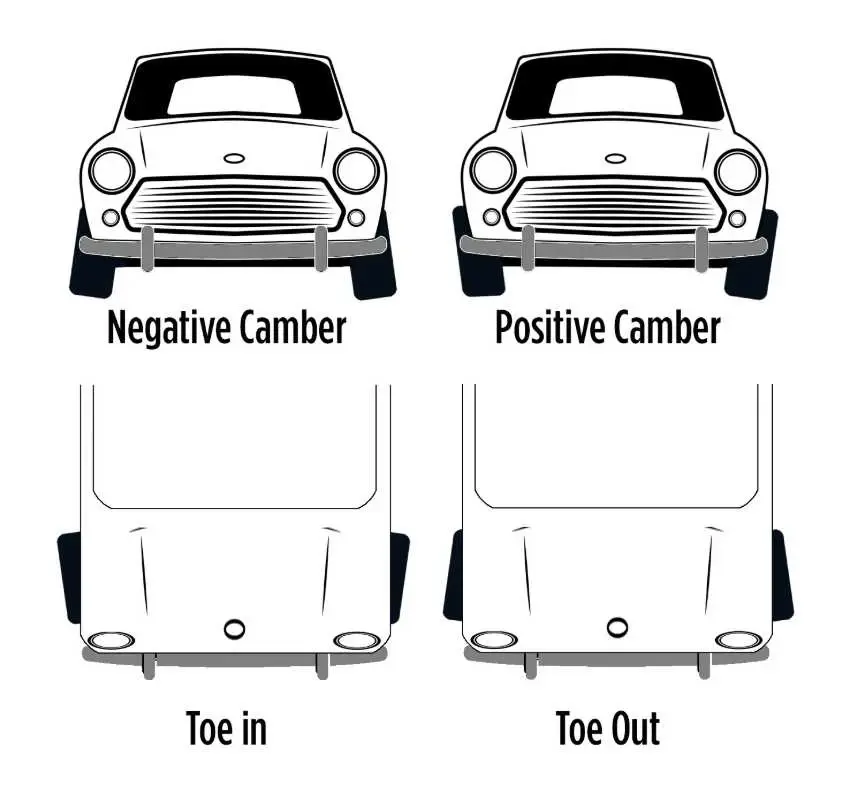
We all notice a leaky tyre, a cracked windscreen, a flat battery and the like, but there are a host of other things that escape our notice from day to day. Some issues make themselves known gradually, and may go unnoticed for some time, especially if they develop slowly.
Wheel balancing and alignment can be like that. In fact, many people hear the words balancing, alignment and tracking used by staff at tyre replacement centres, without having much idea exactly what the tyre chap is really talking about.
What we do know is that sometimes our cars vibrate when they shouldn't; sometimes our steering seems to pull slightly in one direction; our tyres sometimes wear unevenly and it sometimes seems as if our cars use more fuel than they used to. All these symptoms can have multiple possible causes, but they can often be traced to something relatively quick and inexpensive to fix. Having your wheels and tyres properly set up can sometimes cure all the annoying quirks listed above.
So what are wheel balancing, tracking and alignment, and how do they affect your day-to-day driving?
Wheel balancing
What is it?
Wheels and tyres may have minute variations in the composition of the materials from which they are made. There may also be certain structural factors that mean the weight is not perfectly evenly distributed around the circumference of the tyre or wheel. Take a tyre valve, for example: the area of a tyre where the valve is fitted will vary in weight slightly from the opposite side. When a tyre is fitted to a wheel, the wheel's balance is affected by the tyre in addition to any imbalance that may already be present on the wheel itself.
Why is it important?
When the weight of a wheel with a tyre fitted is not evenly distributed, the wheel is unbalanced. If we drive with that unbalanced wheel on our car, we are likely to notice vibration at a certain speed, or speeds. The vibration may be mild but it can be quite severe.
As well as making driving an unpleasant task, vibration from unbalanced wheels can cause premature wear on suspension components and tyres. It can also affect your control of the vehicle, thus posing a potential safety hazard.
How is it fixed?
When you have a new tyre fitted, a legitimate supplier will balance the wheel for you when they put the new tyre on the rim. Over time, changes to the composition, shape, weight and condition of the tyre will mean that the wheel may become unbalanced again. For this reason, it is a good idea to have all the wheels rebalanced when you have a tyre changed.
When balancing a wheel, the tyre technician will use a machine that spins the wheel and checks its balance. The machine tells the technician where to fit small weights to even out the weight distribution, and exactly what size of weight is required. On standard steel rims, the weights usually clip onto the rim, while on aluminium rims, adhesive weights are the usual choice.
Wheel balancing is fairly inexpensive, costing approximately £5 - £10 per wheel. It is generally considered to be money well spent.
Wheel alignment / tracking
What is it?
Where balancing ensures that the weight of the wheels is correctly distributed, alignment or tracking (different terms widely used to mean the same thing) ensures that the wheels are set at the correct angles.
There are two settings that are adjusted when aligning wheels. The first is known as "toe": this refers to how parallel the wheels are to each other when the car is seen from above. Ideally, wheels would be parallel, like this, |----|, when seen from above, with the front of the car pointing to the top of the page. If the actual alignment is like this, /-----\, angled in towards the front of the vehicle, it is said to be "toe in". If it is the opposite way, \-----/, angled out towards the front, then it is said to be "toe out".
Alignment can be affected by a number of things, including bumping kerbs, driving over potholes and more. Over a period of time, the alignment of your car's wheels may deviate from the best setting.
The second setting is called "camber". Camber is the vertical angle of the wheels as seen from the front or rear of the vehicle. Ideally, the camber, when seen from the front of the car, would appear like this |-----|. If it is more like this, /-----\, angled in at the top, it is known as "negative camber". The opposite, "positive camber", looks like this, \-----/, angled out at the top.
These are illustrated in context in the image below.

Why is it important?
Incorrect alignment, like poor balancing, can result in premature or uneven wear on tyres, increased fuel consumption and poor road holding. Again, some of the effects present potential safety hazards.
How is it fixed?
In practice, there are several different alignment settings recommended for different kinds of vehicle suspension. Your tyre centre, garage or mechanic will know which is appropriate for your car.
Alignment in a modern, well-equipped workshop is usually carried out with a machine that produces a detailed report telling the mechanic exactly what needs adjusting. The car is raised, laser sensors are attached to the wheels and then accurate measurements are made by the machine. The actual adjustments are still made the old-fashioned way, by someone wielding a wrench.
There are several more factors and measurements involved than just toe and camber, but they are not as straightforward to explain and, unless you're doing the work yourself, you don't really need to know every little detail.
Having all four wheels aligned usually starts around £75.
We should mention that reports of wheel alignment scams are not uncommon. Some motorists have said that they agreed to have their wheels balanced but, for various reasons, they believe that the work was not really done. Unless we, ourselves, are mechanics, we have little choice but to put some trust in the professionals who maintain our vehicles. That said, we can attempt to ensure that we get what we pay for.
So, what can you do? Consider using a garage whose workshop uses something like a Hunter wheel alignment system. With this kind of equipment, the shop should be able to provide you with pre- and post-adjustment reports. Before having your wheels aligned, ask if they do full alignment including "camber", "toe" and "caster", and if they can supply before and after reports generated by their system. You may not really have the first clue what they, or you, are talking about, but you don't have to make it obvious. You may be more likely to get what you pay for if the people working on your vehicle suspect you know more about the job than the average punter.
